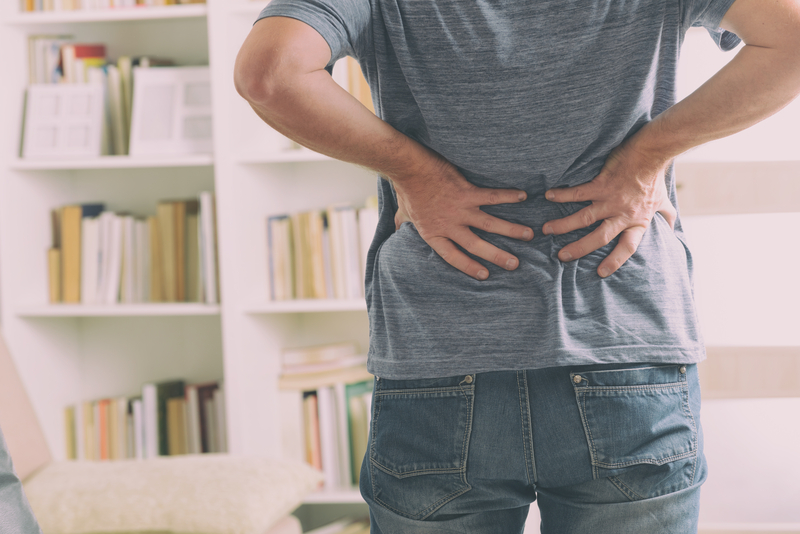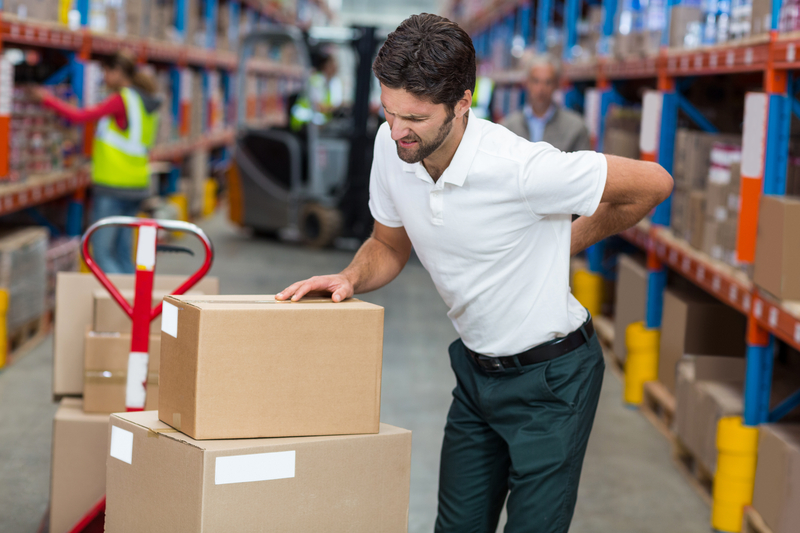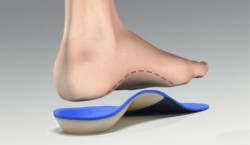Lower Back Pain
Around four out of five people have lower back pain at some point in their lives. In fact, lower back pain is one of the most common reasons people visit Central Park Chiropractic to get help with lower back pain.
Low back pain can result from many different injuries, conditions or diseases — injury to muscles or tendons in the back, arthritis, structural problems and disk conditions or injuries.
The intensity of pain can range from dull and mild to acute and severe. In some cases, pain can make it difficult or impossible to walk, sleep, work or do everyday activities.

Usually, lower back pain gets better with rest. To mitigate the risk of severe complications, it is advisable to undergo a comprehensive evaluation to rule out an underlying disease or a significant injury that may be causing lower back pain. Whenever in doubt, don’t hesitate to schedule an appointment to see Dr. Kaila or call our Central Park Chiropractic office at 604 439-1230. With proper care and treatment, you can accelerate your return to work, enjoy playing sport and get back to your favorite activities, all free from constraints or pain.
Symptoms and Causes
Common Symptoms of Lower Back Pain: Symptoms of lower back pain may develop slowly and gradually or manifest as a sudden onset. Occasionally, pain occurs after a specific event, such as bending to pick something up, while at other times, the cause may be unclear.
The intensity of lower back pain can range from sharp to dull and achy, often radiating to the bottom or down the back of the legs (sciatica). Pain tends to worsen in certain positions, such as bending over, but often improves when lying down.
Lower Back Pain symptoms may also include:
- Back stiffness: It may become difficult to move or straighten your back. Getting up from a seated position may take a while, and you might feel like you need to walk or stretch to alleviate stiffness and a decreased range of motion.
- Posture problems: Many people with back pain describe challenges to standing up straight. In effort to cope, patients often adopt a “crooked” or bent posture, with the torso off to the side instead of aligned with the spine. The lower back may appear flat rather than curved.
- Muscle spasms: Following a strain, muscles in the lower back can spasm or contract uncontrollably, causing extreme pain and make it difficult or impossible to stand, walk or move.

Diseases, injuries, or medical conditions that may lead to a rapid or gradual development of lower back pain.
Strains and sprains: Back strains and sprains can occur by lifting heavy objects improperly. Some patients report straining their back as a result of sneezing, coughing, twisting or bending over.
Car Incident Injuries: Spinal bones fractures as well as strain and sprain of muscles, ligaments and tendons may occur during car accidents, especially collisions or rollovers. Certain pre-existing conditions, such as spondylolysis or osteoporosis may increase the risk of trauma.
Disk problems: Disks (soft, rubbery tissue) cushion the vertebrae (small spinal bones). Disks can bulge from their position in the spine and press on a nerve. They can also tear (herniated disk). With age, discs between vertebrae break down, decreasing the space between them and irritating surrounding nerves (degenerative disk disease).
Structural problems: Condition like spinal stenosis occurs when the spinal column is too narrow for the spinal cord. Severe lower back pain can be caused by an object or structure pinching and/or compressing the spinal cord. Unusual curvatures of the spine, such as scoliosis, lordosis, and kyphosis, can result in pain, stiffness, and challenges in mobility.
Arthritis: Osteoarthritis and ankylosing spondylitis are common types causing inflammation, stiffness, and lower back pain.
Disease: Spine tumors, infections, cancers, kidney stones, and abdominal aortic aneurysms can be associated with back pain.
Spondylolisthesis: This condition, involving the displacement of vertebrae (slip out), results in low back pain and often leg pain.
Foot or arch misalignment: Flat feet or feet excessive pronation (inward rolling), can result in internal rotation of the ankle, knees, groin, and pelvis. These rotations contribute to a forward tilt of the pelvis, leading to an increased curvature of the spine. This, in turn, places strain on the muscles, tendons, and ligaments of the lower back, ultimately causing inflammation and pain.

Low Back Pain Risk Factors
Certain factors increase the likelihood of developing and experiencing lower back pain:
Age: People over 40 are more prone to back pain as spinal disks wear away and weaken with age.
Weight: People who have overweight/obesity or carry extra weight are more likely to have back pain due to increased pressure on joints and disks.
Overall health: Weakened abdominal muscles, sedentary lifestyles, smoking, and excessive alcohol consumption heighten the risk of back pain.
Occupation and lifestyle: Jobs and activities involving heavy lifting or bending increase the risk of back injuries.
Structural problems: Severe back pain can result from conditions, such as scoliosis, lordosis, kyphosis (unusual curvature of the spine), that change spine alignment.
Foot misalignments: Because our feet are the foundation of our posture, any misalignment of them can negatively influence the rest of our posture. Thus, it’s not uncommon that issues originating in the feet may affect the posture and lead to back pain.
Disease: Family history of osteoarthritis, certain cancers, and other diseases elevates the risk of low back pain.
Mental health: Depression and anxiety can contribute to back pain.
Diagnosis and Tests
How is lower back pain diagnosed?
Dr. Kaila will ask about your symptoms and do a physical exam. To rule out structural damage or severe underlying health conditions, Dr. Kaila may order imaging studies:
- Spine X-ray, which uses radiation to produce images of bones.
- MRI, which uses a magnet and radio waves to create pictures of bones, muscles, tendons and other soft tissues.
- CT scan, which uses X-rays and a computer to create 3D images of bones and soft tissues.
- Electromyography (EMG) to test nerves and muscles and check for neuropathy (nerve damage), which can cause tingling or numbness in your legs.
Management and Treatment
At Central Park Chiropractic and Massage, we employ natural and safe procedures to effectively manage lower back pain. Dr. Kala focuses on identifying and correcting the underlying issues that contribute to the majority of cases of low back pain.
The treatment plans for lower back pain are tailored based on the specific cause and may include:
- Hands-on manipulation: The chiropractic spinal adjustment is a noninvasive therapy that entails a gentle application of force, either manually or mechanically, to specific segments of the spinal column. Extensive research supports the efficacy of spinal adjustments, showing benefits such as pain reduction, increased spinal range of motion, decreased muscle spasm, reduced inflammation, optimized spinal biomechanics, and a lower recurrence of previous injuries.
- Medications: Dr. Kaila might suggest nonsteroidal anti-inflammatory drugs or prescribe medications to alleviate pain. Other drugs can assist in muscle relaxation and prevent back spasms.
- Massage and physical therapy: Massage contributes to muscle relaxation, and physical therapy can enhance muscle strength, offering better support for your spine. Additionally, physical exercises may help improving flexibility and reduce the risk of further injuries.
At-home treatment for lower back pain
Important!
Consult with Dr. Kaila before starting any new exercise or treatment plan for your lower back pain.
- Relax. Sometimes just sitting down will relieve enough of the pressure from your lower back to reduce the pain significantly.
- Exercise and stretching. While exercise is generally beneficial for addressing lower back pain, it is always a good idea to consult with Dr. Kaila before engaging in any new exercise regimen. Some exercises can make the pain worse. Generally getting into better physical health will help reduce lower back pain particularly during activities like standing and everyday activities and task.
- Stand and sit up straight. Your posture is important for proper weight distribution. Standing and sitting up straight will help.
- Get supportive shoes and orthotics. Get shoes or shoe inserts (custom orthotics) that help keep your feet in a neutral, supported position.
- Mattress support. Find a mattress that gives you better support than your current one.
- Avoid heavy lifting. Avoid lifting heavy objects. If you must, keep your back straight and bend your legs so the leg muscles do the majority of the work.
- Lose weight. If you’re overweight, getting to a healthy weight will improve strain on your back.

When you should see Dr. Kaila about your lower back pain?
Lower back pain usually gets better with rest and pain relievers. Back pain that doesn’t go away may be a sign of a more serious condition.
Call Central Park Chiropractic, Burnaby office at 604 439-1230 or Book an Appointment Online if you experience:
- Pain that doesn’t get better after about a week of at-home care.
- Pain that’s unaffected by activity or position.
- Rigid spine.
- Prolonged morning stiffness.
- Tingling, numbness, weakness or pain in your buttocks or legs.
- Severe pain or muscle spasms that interfere with your normal activities.
- Fever, unintentional weight loss, bowel or bladder problems or other unexplained symptoms.
Prevention
Is it possible to prevent lower back pain?
You can’t prevent lower back pain that is stemming from diseases or structural issues in the spine but you can avoid injuries that cause back pain.
To reduce your risk of a back injury, you should:
- Maintain a healthy weight: Excess weight places undue pressure on vertebrae and disks.
- Strengthen your abdominal muscles: Engage in activities such as Pilates and other exercise programs that focus on building core muscles, providing support to the spine.
- Lift with proper technique: Minimize the risk of injuries by lifting heavy objects with your legs, not your back. Keep heavy items close to your body and refrain from twisting your torso while lifting.
Prognosis
Millions of people live with low back pain. Stiffness, pain and limited movement can have a major impact on quality of life. But you may be able to avoid lower back pain by maintaining a healthy weight and staying active. Most people with back strains and sprains recover and do not have long-term health issues.
Talk to Dr. Kaila if back pain doesn’t go away or if you’re unable to do the activities you enjoy. Several treatments can relieve pain, help you move better and get more out of life.
Got questions?
Call Central Park Chiropractic, Burnaby office at 604 439-1230
or
Book an Appointment Online


